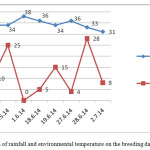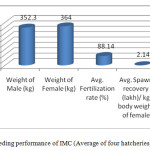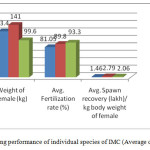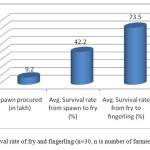Introduction
Aquaculture is considered as one of the booming sector in India providing livelihood to millions of farmers. One of the cheapest protein meat “fish” has the vast potential to contribute for the national food and nutritional security. India ranks third second in world fish production, contributing about 9.58 million tonnes of fish.1 which again expected to reach 12.5 million tonnes by 2025. The sector contributes about 0.83 % to overall GDP and represents 4.75% of agricultural GDP.2 Though the technique of carp seed production (induced breeding and multiple spawning) is well standardised3,4.5,6,7 the availability of quality seeds is one of the major impediments in expansion of aquaculture in India. The network of hatcheries comprised of public and private sectors in India has grown substantially but the position to meet the demand of quality seeds is not encouraging. The distribution system of carp seed is complex and dynamic. Though some of the entrepreneurs produce and supply the fish seed to end users often as a part of complex networks, their supply remains erratic in other part, particularly in rural sectors.8
Indian major carp (IMC) viz. Catla (Catla catla,) Rohu (Labeo rohita) and Mrigal (Cirrhinus mrigala) brood stock management is the prime consideration for producing quality broods as well as seed for successful aquaculture in the country. In the recent times, there are concerns about the quality of seed primarily due to non-availability of suitable and healthy brood stock due to improper feeding.
Inland aquaculture in India is centred on the Indian Major Carps and these fishes spawn during the monsoon season (June-August) and extend till September.9 Lowering of temperature even without rainfall will bring about ovulation or spermiation in Indian major carps which is the rationale behind CIFRI’s early breeding programme of both major and exotic carps in different seasons.10 In this context, ICAR-Central Institute of Freshwater Aquaculture conducted research and developed a brood stock diet ‘CIFABROODTM’ for early maturation of broods and producing quality seeds. CIFABROODTM,as a brood stock feed advances maturation and growth of gonads, facilitating early spawning and significantly increases spawning response This may be due to increase in the level of prostaglandin and sex steroids particularly estrogens and progesterone.21 It is suitable for multiple/repeated breeding, out of season gonad growth and post spawning recovery. The role of CIFABROODTM in out of season gonadal growth is bonus effect observed frequently but the scientific rationale has to be established.11
With the mandate of KVK on technology assessment a trial was conducted with CIFABROODTM in selected hatcheries of Khordha district. The total area under freshwater aquaculture accounts to 1929.24 ha which comprised of tanks and ponds producing about 15,760 MT of fish and shell fish in Khordha district of Odisha, India.12 Agriculture is the mainstay; however animal resources and fisheries are also the prevailing livelihood assets of rural communities. Fisheries resources of the district are freshwater tanks and ponds suitable for aquaculture. The species cultured are Indian major, minor and medium carps and prawn.
Fish seed is produced by both government and private hatcheries and significantly the private hatcheries being developed and technically guided by Krishi Vigyan Kendra (KVK), Khordha produced 31 crores of spawn which constitute 63.78 percent of the total spawn production in the district.13 Although few success cases of carp seed production in rural villages like Sarakana, Kantapada and Bhatapadgarh of Khordha district, Odisha was well documented8,14 but early breeding and seed production of carps in the district is yet not reported. Hence, this study was conducted with the objectives to analyse the performance of CIFABROODTM at farmer’s field through adaptive trial, to study the attributes of the innovation and to understand the perception of hatchery owners and fish seed buyers on off season fish seed production.
Materials and Methods
Scoping and Pre-diagnostic study
A pre adaptive trial study was conducted by an interdisciplinary team consisting of biologists, social scientists and field level extension workers. The study tailored towards understanding the status of hatcheries, capacity to hold the trial and perception of hatchery owners towards off season fish seed production. With this background a one day preliminary inception meeting was organised to chalk out the adaptive trial. Baseline data were collected from the hatcheries and also presented in the meeting. A preliminary survey was conducted in all nine hatcheries of the district to map out pre-monsoon breeding incidents and prevalence in the operational area and it was observed that none of the hatcheries were involved on such attempts. At the initial stages the hatchery owners were reluctant to accept the feed due to a fear of distress sale and unpreparedness of seed producers to aggregate the buyers to procure the seed. After convincing the hatchery owner, four hatcheries from two blocks viz., Balianta and Banapur were selected. Complete scientific package of practices for brood raising were also informed.
Table 1: Attributes of Innovation and incentives for adoption.
|
Attributes of Innovation CIFABROODTM |
Responses/reflections towards rate of adoption |
| Relative Advantage | |
| Economic profitability, Social prestige and other benefits | The innovation is economically profitable in catering fish seed production during off season. However, the cost of feed is a serious concern and the innovation will be more profitable if off season produced fish seed gets a higher price than fish seed produced during monsoon season normally. However, there is no sign of the feed to be a preventive innovation. |
| Compatibility | |
| Consistent, with the existing values, past experiences, and needs of potential adopters | Consistent with existing values as fish seed are produced during off season which paves way for availability of fish seed all round the year and which touches core of increasing fish production. Feedback to research system about the assessment results if widely published will have more potential adopters. |
| Complexity | |
| Relatively difficult to understand and use | The innovation is easy to understand and ease to use if package of practices are well defined to users. |
| Trialability | |
| Innovation may be experimented with on a limited basis. | The feed can be experimented with a limited basis, however hatchery owners should know the source of technology and procuring the source of feed |
| Observability | |
| Results of an innovation are visible to others. |
The spawn recovery, survival rate of fry and fingerling are very much visible. |
Study Site
The study was conducted in Khordha (20.1301° N, 85.4788° E) one of the 33 districts of Odisha state. Four hatcheries from two blocks viz., Balianta (20.3085° N, 85.8866° E) and Banapur (19.7714° N, 85.1635° E) were selected to investigate the performance of CIFABROODTM on breeding performance of brood stock.
Table 2: Perception and responses of hatchery owners on CIFABROODTM and process of seed production in off season
|
Perception |
Responses |
|
Feed acceptability by broods |
Very high in terms of fish accepting the feed |
|
Egg recovery in quantity |
High in terms of egg recovery in quantity during off season |
|
Spawn recovery |
Healthy spawn with good survival rate |
|
Affordability of Feed cost |
Feed cost is high |
|
Market |
New market has emerged as there is a demand for seed in off season |
|
Preparatory measures by buyers of off season seed |
Buyers are interested to plan for off season fish seed production |
Pond preparation and stocking
Two brood stock ponds of equal size (0.3ha) located side by side in the farm complex were selected from each hatchery. Ponds were dewatered and treated with quick lime @200kg/ha and the bottom was exposed to sunlight for a week and refilled with water drawn from adjacent ponds and bore well sources. Ponds were fertilized as per the water quality testing result and Indian Major Carps (Catla, Rohu and Mrigal) were stocked @ 1000 kg/ha during 15th February, 2014 with the individual weight ranging from 1.6 kg to 2.8kg.
 |
Figure 1: Fluctuation of rainfall and environmental temperature on the breeding days. Click here to View figure |
 |
Figure 2: Breeding performance of IMC (Average of four hatcheries) Click here to View figure |
Feeding schedule and Sampling
Fishes in control pond were fed with the farm made feed prepared from feed ingredients like ground nut oil cake, rice bran and maize flour. In trial ponds fishes were fed with CIFABROODTM @3% of body weight from 25th February 2014 (after acclimatising for 3-4 days with CIFABROODTM). Daily feeding was monitored for observing the intake rate and feed acceptability. Sampling of fishes was done fortnightly to identify the initiation of phenotypic maturation in both the trial and control ponds. After completion of 45 days of feeding, observations on gonadal maturity, oozing and external lustre were collected. Monitoring of water quality was analysed in regular interval of fifteen days.
 |
Figure 3: Breeding performance of individual species of IMC (Average of four hatcheries) Click here to View figure |
 |
Figure 4: Survival rate of fry and fingerling (n=30, n is number of farmers) Click here to View figure |
Induced breeding and hatchery owners’ feedback
Single species matured brood were bred in cemented Chinese carp hatchery separately to avoid inbreeding and production of unhealthy spawn. Wova-FHTM (Synthetic gonadotropin releasing hormone analogue, SGnRH of Biostadt India Limited, India) was used as the synthetic inducing agent for the whole breeding season. Ovaprim was not used by the farmers due to unavailability and supply in the locale. Male and female fishes were administered a dose of 0.2ml-0.3ml and 0.4-0.5ml/kg of body weight respectively. Breeding performance on the basis of weight of male and female brood, fertilization rate and spawn recovery were recorded. Daily rain fall and temperature data were collected from Indian meteorological website. Perception of hatchery owners towards the feed and process of off season seed production were collected. The study for understanding the feedback on early breeding, quality of spawn and attributes of innovation were elicited by using Focus Group Discussion method.
Seed growers’ feedback on fry and fingerling production
Data on survival rate of fry and fingerling were collected from 30 spawn buyers, who procured the spawn from the trial hatcheries. A feedback of these farmers on various parameters and perception on off season fish seed production and its usefulness were recorded.
Result and Discussions
On-farm trial, management and monitoring
On-Farm Trial (OFT) of KVK is to assess the suitability of new technologies generated by research system at farmer field for further refinement and to provide feedback to the research system. An OFT aims at testing a new technology or an idea in farmer’s field, under farmers’ conditions and management, taking farmer’s own practice as control. It should help to develop innovations consistent with farmer’s circumstances, compatible with the actual farming system and corresponding to farmer’s goals and preferences.15
After preliminary rejection due to preconceived ideas about new technologies and lack of buyers during off season, two hatchery owners were successfully convinced and the trial was initiated. In the sideline seed producers (fry and fingerling producers) were contacted by the hatchery owners for pond preparation to procure the seed. The information on CIFABROODTM to the farmers was provided in simple language and extension literature. During feeding process, it was observed that the voluntary feed intake of fishes were excellent according to the farmer. The fishes in the trial ponds looked healthier and glazy shining in their phenotypic appearance.
Breeding Protocol and Spawn Production
Within 30 days of feeding, the initiation of phenotypic maturation was observed in the trial ponds but it was absent in the control pond. After completion of 45 days of feeding it was observed that more than 95% of fishes were matured and ready to breed where as fishes from controlled ponds were phenotypically immature. Sampling of fishes for checking the maturity was done through stripping method.
The induced breeding was conducted in an atmospheric temperature ranging from310C to 380C (Month of May-June). A total number of nine breeding programmes were studied in the trial. The variation of average environmental temperature and rainfall during the whole induced breeding activities is shown in the Fig.1. The trend from the figure indicates an erratic rainfall and high temperature during the pre-monsoon periodand particularly on different breeding days.
All three species (Catla, Rohu and Mrigal) were bred in separate spawning pools to avoid inbreeding and unhealthy spawn production. The overall breeding performance of these species from all the four hatcheries were summarised in Fig.2. From all the nine breeding programmes a total of 364 kg of female fish were bred. The results indicate an average fertilization rate of 88.14% and average spawn recovery of 2.14 lakh/kg body weight of female. This result is highly encouraging considering the climatic condition of temperature and rainfall.
The breeding performance of individual species of IMC from all the four hatcheries is indicated in Fig. 3. Highest average fertilization rate was found in mrigal followed by rohu and catla. Although the fertilization rate of all the three species were high and encouraging but the highest fertilization rate in mrigal needs to be studied further.
Similarly average spawn recovery per kg of female body weight after 72 hours of hatching was calculated. The result indicates a highest recovery in rohu followed by mrigal and catla. It was found from earlier works and farmers’ experience that among IMC, catla is more sensitive to high temperature and rainfall fluctuation. The trial resulted in early spawning and excellent recovery of healthy spawn with higher survival rate,which can help the hatchery owners to mark a place for themselves in the future seed market during off season.
Fry and Fingerling Production
From the hatcheries owners list 30 buyers were selected randomly for the study who have procured seeds. A total of 9.2 lakh spawn were procured by these farmers for fry and fingerling production. The data on survival rate, quality of seed and their growth rate were obtained through personal contacts and telephonic conversation. The calculated average survival rate of fry and fingerling were found to be 42.2% and 73.5% respectively (Fig.4). The survival rate from fry to fingerling of this early bred spawn is in line with the studies of other authors16 who have observed that there is an average 80% of survival rate by adopting modern practices. Maximum survival obtained was 61.6%, 67.8% and 69.9% in catla, rohu and mrigal respectively at 2.5 million/ha stocking density.17
Feasibility to Market
The fish seed production and marketing in private sector networks are complex and dynamic.18 The seeds produced in the participant hatchery due to early maturity had adequate takers and as indicated there was also a considerable success in the survival rate. An increment in the price of off season seed can make the feed cost rewarded. There has been a huge demand of fish seed in Odisha which is fulfilled mostly by West Bengal during the pre-monsoon period. Opportunities are there to tap the potential of the technology for year round quality seed production in the state.
Attributes of Innovation and Incentives for Adoption
The perceived attributes of an innovation are one important explanation of the rate of adoption of an innovation.19 The five attributes of innovations viz., relative advantage, compatibility, complexity, trailability and observability were studied with CIFABROODTM with participant and non participant hatchery owners.
All the attributes of the innovation were evident towards a high rate of adoption in future within the hatchery owners. The positive outcomes of the attributes of innovation are highly towards an increased rate of adoption especially with the attributes viz., compatibility, complexity, trialability and observability (Table 1). The concern over the feed is on the cost as the traditional feed accounts to Rs. 30/kg and CIFABROODTM to Rs.81/kg. However, the study a indicate that an estimated expenditure for feeding 1000 kg brood stock is about Rs. 90,000 and farmer can gain additional Rs.10.50 lakhs through use of CIFABROODTM.20 With the attributes of innovation it could be understood that the feed can have a higher rate of adoption.
Response of Hatchery owners on the feed
The issues pertaining to early breeding and spawn produced during off season questions many hatchery owners in relation to market. The study intended to assess the perception of hatchery owners towards production of off season fish seeds and the saleability and concerns from buyers. The study inferred that hatchery owners were concerned on feed acceptability, high fecundity, spawn recovery, feed cost and the market. The perception and responses towards the feed and off season fish seed production is presented in Table 2. Hence it could be concluded that the perception of hatchery owners on the feed was satisfactory in terms of the technology, process and impact in terms of economic benefits. Above all there was a high response towards the feed acceptability by the broods which is the key to the technology.
Conclusions And Recommendations
On-farm trial demands intensive efforts from experts to provide information and knowledge in an intensified package of practice for adoption. The initial process of convincing farmers was intense as there were questions from the hatchery owners about the market for off season seed production and preparedness of buyers. The observed spawn recovery was found to be encouraging and this was the moot towards building confidence to adopt the brood stock diet. The high price of CIFABROODTM in comparison to traditional feed will be compensated in future as the price of off season fish seed will cost more than the fish seed produced during the normal season. It is high time that more and more hatcheries need to be brought under the adoption of new breakthrough technologies for higher production in fisheries sector.
Acknowledgements
The authors thank all the hatchery owners who were involved in testing CIFABROODTM in their farms and supporting the team to document this paper.
References
- FAO, 2016. FAO year book, 2014 Fishery and Aquaculture statistics. Food and Agriculture Organisation of the United Nations, Rome, Italy: 105 pp
- Hand book on fisheries statistics, 2014. Department of Animal husbandry, Dairying and Fisheries, Ministry of Agriculture, Government of India, New Delhi. 166 pp.
- Bhowmik R.M., Kowtal G. V., Jana R. K., Gupta S. D. Experiments on second spawning of major Indian carps in the same season by hypophysation. Aquaculture, 12:149-155 (1997).
CrossRef - Chaudhuri H., Singh, S. B. Induced breeding of carps. Indian Council of Agricultural Research, New Delhi, India. 82 (1984)
- Gupta S. D., Rath S. C., Dasgupta S., S.D. Tripathy, S. D. A first report on quadruple spawning of Catlacatla (Ham.). Veterinarski Arhiv. 65:143–148 (1995).
- Chattopadhyay N.R, Ghorai P.P and S.K. De. Bundh breeding-rejuvenation of a novel technology for quality seed production by the fish seed producers of Bankura District in west Bengal, India. Int. J Curr Sci, 9: E 123-132 (2013)
- Murthy K.S., Ventakateshwaralu M and B. R. Kiran. Induced breeding of Indian Major, Minor and Cyprinid in India: An overview, JIARM 1(6): 165-193 (2013)
- Radheyshyam. Carp seed production at rural front in Orissa, India. Aquaculture Asia, 15 (2): 20-24 (2010).
- Das M.K and A.P. Sharma. Add fisheries and aquaculture management to our solutions for climate change and food security. Bulletin No. 167. Central Inland Fisheries Research Institute, Barrackpore (2010).
- CIFRI. CIFRI’s Major Breakthrough in Off season carp breeding. CIFRI Newsletter, 7 (1&2): (1984)
- CIFA. Early Breeding of Indian Major Carps under CIFABROOD Demonstration Trial. http://www.icar.org.in/en/node/6473, accessed June 6, 2016, (2016)
- DFO. Annual report/Progress report of District Fisheries Officer, Khordha, Odisha (2015)
- Ananth P.N., Sahoo P.R., Pati B.K., Dash A.K., Barik N.K., Jayasankar P. and S.R. K. Singh. A Study on the performance of small holder carp hatcheries in Khordha district of Odisha State, India. Ecology, Environment & Conservation, 21 (1): 329-336, (2015)
- Sahoo P.R., Pati B.K., Ananth P.N., Dash A.K and P. Jayasankar. A study on potentials of utilising seasonal fallow ponds for carp fingerling production in Khordha district, Odisha. Ecology, Environment & Conservation. 21 (1):273-276, (2015).
- Venkatasubramanian V., Sajeev M.V. and Singha A.K. 2009. Concepts, Approaches and Methodologies for Technology Application and Transfer: A Resource Book for KVKs, ICAR, New Delhi. 592 pp
- Das P and V.R.P Sinha. Carp Seed Rearing: Package of Practices for increasing production. Central Inland Fisheries Research Institute, Barrackpore, 22pp, (1985)
- Jena J.K., Arvindakshan, P.K and W.J.Singh, W. J Nursery rearing of Indian major carp fry under different stocking densities, Indian Journal of Fisheries, 45(2): 163-168, (1998)
- Milwain G., Little D.C., Kundu N and A. Immink, 2002. Overview of fish seed production and distribution in West Bengal, India. Working Paper for R7502 (DFID/AFGRP). Calcutta, India, Institute of Aquaculture, University of Stirling and Institute of Wetland Management and Ecological Design. 86 pp, (2002)
- Rogers E. M. Diffusion of innovations (4th ed.). New York: Free Press. 518pp, (1995)
- Nandi S., Barik N. K., Sahoo P.R., Ananth P.N., Nayak A.P., Sundaray J.K and P. Jayasankar. CIFABROODTM as Carp Broodstock Diet: Experience from Famers pond. CIFA Extension Series-9: 8pp, (2014)
- Nandi, S., Chattopadhyay, D. N., Verma, J. P., Sarkar, S and Mukhopadhyay, P.K. Effect of dietary supplementation of fatty acids and vitamins on the breeding performances of the carp Catla catla. Reprod. Nutr. Dev. 4: 365-37, (2001).
CrossRef
